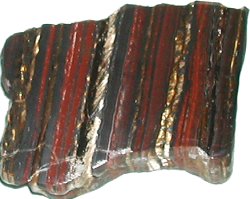
 |
In focus: Banded Iron Formation |
|
Banded Iron formations (BIFs) are among the oldest rocks on Earth. They are marine-derived sedimentary deposits (i.e. they are rock formed from matter which gathered on ancient seabeds, and were turned to rock by time and pressure) consisting of alternating layers of iron-rich rocks (mostely magnetite, siderite, and hematite) and silica (chert). BIFs contain at least 15% iron in the form of Fe+2 and Fe+3. The layers are relatively thin, varying from a few millimeters to several centimeters thick. Although some believe that there are larger masses of BIF rocks which have layers that are meters deep. |
The formation of BIFs started in the Proterozoic area around 1.8-2.5 billion years ago, at the time when Earth's atmosphere was devoid of oxygen and consited mainly of methane. There was a high concentration of iron sea at that time. The formation of BIFs was initiated by a bacterium called Cyanobacteria. Cyanobacteria was the very first life form to use water and the sun for photosynthesis, a process which produced free oxygen as a waste product. The increase in oxygen levels caused the oxidation of free iron in the sea. This fell as iron oxide particles to the bottom of the sea, giving rise to the original layer of BIF. To learn more about this process see our August Editorial. Although the early events leading to the precipitation of iron oxide are relatively srtaightforward, the processes which led to the layering of iron-rich and silica rich materials are not understood. Some scientists belive that the formation of banded iron deposits originated in an upwelling continental shelf setting and this can be linked to geologic phenomena such as sea transgression (a relative rise in sea level resulting in marine strata being deposited over terrestrial strata). However, the latter processes are still under constant dispute.
BIFs can be subclassified into three major subcategories:
BIFs are very complex rocks and many do not fit completly into these three categories, including so-called sulphide-facies BIF which contains pyrite. Sulphide addition to BIFs is thought to be a secondary replacement rather than the original sedimentary formation. These sort of secondary events and recrystalization add to the complexity of BIFs chemistry.
| _______________________________ | ||||
| Home | | | Shopping | | | Database |
© Biscuit Software 2004-2015
All rights reserved